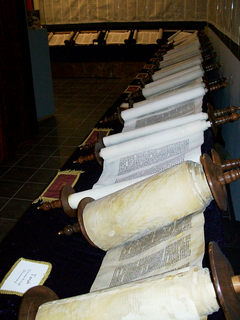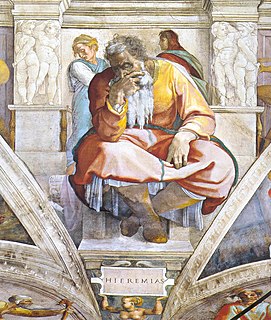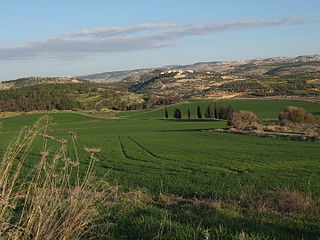
The Bible is a collection of sacred texts or scriptures. Varying parts of the Bible are considered to be a product of divine inspiration and a record of the relationship between God and humans by Christians, Jews, Samaritans, and Rastafarians.

Different religious groups include different books in their biblical canons, in varying orders, and sometimes divide or combine books. The Jewish Tanakh contains 24 books divided into three parts: the five books of the Torah ("teaching"); the eight books of the Nevi'im ("prophets"); and the eleven books of Ketuvim ("writings"). It is composed mainly in Biblical Hebrew, and its Masoretic Text is the main textual source for the Christian Greek Old Testament.

The Book of Esther, also known in Hebrew as "the Scroll" (Megillah), is a book in the third section of the Jewish Tanakh and in the Christian Old Testament. It is one of the five Scrolls (Megillot) in the Hebrew Bible. It relates the story of a Hebrew woman in Persia, born as Hadassah but known as Esther, who becomes queen of Persia and thwarts a genocide of her people. The story forms the core of the Jewish festival of Purim, during which it is read aloud twice: once in the evening and again the following morning. The books of Esther and Song of Songs are the only books in the Hebrew Bible that do not explicitly mention God.

Esther is described in the Book of Esther as a Jewish queen of the Persian king Ahasuerus. In the narrative, Ahasuerus seeks a new wife after his queen, Vashti, refuses to obey him, and Esther is chosen for her beauty. The king's chief advisor, Haman, is offended by Esther's cousin and guardian, Mordecai, and gets permission from the king to have all the Jews in the kingdom killed. Esther foils the plan, and wins permission from the king for the Jews to kill their enemies, and they do so.
Malachi, Malachias, Malache or Mal'achi was the writer of the Book of Malachi, the last book of the Neviim (prophets) section in the Hebrew Bible. No allusion is made to him by Ezra, however, and he does not directly mention the restoration of the temple. The editors of the 1906 Jewish Encyclopedia implied that he prophesied after Haggai and Zechariah and speculated that he delivered his prophecies about 420 BCE, after the second return of Nehemiah from Persia, or possibly before his return, comparing Malachi 2:8 with Nehemiah 13:15.

The Old Testament is the first part of Christian Bibles, based primarily upon the Hebrew Bible, a collection of ancient religious writings by the Israelites believed by most Christians and religious Jews to be the sacred Word of God. The second part of the Christian Bible is the New Testament.

In religion, a prophet is an individual who is regarded as being in contact with a divine being and is said to speak on that entity's behalf, serving as an intermediary with humanity by delivering messages or teachings from the supernatural source to other people. The message that the prophet conveys is called a prophecy.

The Septuagint is the earliest extant Greek translation of the Hebrew scriptures from the original Hebrew. It is estimated that the first five books of the Old Testament, known as the Torah or Pentateuch, were translated in the mid-3rd century BCE and the remaining texts were translated in the 2nd century BCE. Considered the primary Greek translation of the Old Testament, it is quoted a number of times in the New Testament,particularly in the Pauline epistles,by the Apostolic Fathers, and later by the Greek Church Fathers.

Torah has a range of meanings. It can most specifically mean the first five books (Pentateuch) of the 24 books of the Tanakh, and is usually printed with the rabbinic commentaries. It can mean the continued narrative from the Book of Genesis to the end of the Tanakh (Malachi), and it can even mean the totality of Jewish teaching, culture and practice, whether derived from biblical texts or later rabbinic writings. Common to all these meanings, Torah consists of the origin of Jewish peoplehood: their call into being by God, their trials and tribulations, and their covenant with their God, which involves following a way of life embodied in a set of moral and religious obligations and civil laws.

The Hebrew Bible, also called the Tanakh or Mikra, is the canonical collection of Jewish texts, which is also the textual source for the Christian Old Testament. These texts are composed mainly in Biblical Hebrew, with some passages in Biblical Aramaic. The form of this text that is authoritative for Rabbinic Judaism is known as the Masoretic Text (MT), and is divided into 24 books, while the Protestant Bible translations divide the same material into 39 books.
Hebrews is a term appearing 34 times within 32 verses of the Hebrew Bible. While the term was not an ethnonym, it is mostly taken as synonymous with the Semitic-speaking Israelites, especially in the pre-monarchic period when they were still nomadic. However, in some instances it may also be used in a wider sense, referring to the Phoenicians, or to other ancient groups, such as the group known as Shasu of Yhw on the eve of the Bronze Age collapse.

Jeremiah, also called the "weeping prophet", was one of the major prophets of the Hebrew Bible. According to Jewish tradition, Jeremiah authored the Book of Jeremiah, the Books of Kings and the Book of Lamentations, with the assistance and under the editorship of Baruch ben Neriah, his scribe and disciple.

Goy is the standard Hebrew biblical term for a nation. The word nation has been the common translation of the Hebrew goy or ethnos in the Septuagint, from the earliest English language bibles such as the 1611 King James Version and the 1530 Tyndale Bible, following the Latin Vulgate which used both gentile and nationes. The term nation did not have the same political connotations it entails today. The word "gentile" is a synonym for the Hebrew word Nokri which signifies "stranger" or "non-Jew".

Caleb, sometimes transliterated as Kaleb, is a figure who appears in the Hebrew Bible as a representative of the Tribe of Judah during the Israelites' journey to the Promised Land. A reference to him is also found in the Quran, although his name is not mentioned.

The Nephilim were the offspring of the "sons of God" and the "daughters of men" before the Deluge, according to Genesis 6:1-4.
Richard Elliott Friedman is a biblical scholar and the Ann and Jay Davis Professor of Jewish Studies at the University of Georgia.

A biblical canon or canon of scripture is a set of texts which a particular religious community regards as authoritative scripture. The English word "canon" comes from the Greek κανών, meaning "rule" or "measuring stick". Christians became the first to use the term in reference to scripture, but Eugene Ulrich regards the idea as Jewish.

The Land of Israel is the traditional Jewish name for an area of indefinite geographical extension in the Southern Levant. Related biblical, religious and historical English terms include the Land of Canaan, the Promised Land, the Holy Land, and Palestine. The definitions of the limits of this territory vary between passages in the Hebrew Bible, with specific mentions in Genesis 15, Exodus 23, Numbers 34 and Ezekiel 47. Nine times elsewhere in the Bible, the settled land is referred as "from Dan to Beersheba", and three times it is referred as "from the entrance of Hamath unto the brook of Egypt”.
Zabbai was a Palmyrene man who lived in the third century, and likely belonged to the upper-class of Palmyra. An obscure figure, he is mainly known from Queen Zenobia's Palmyrene name mentioned in Palmyrene inscriptions, sptymy'btzby, which translates to Septimia Daughter of Zabbai. Zenobia's Palmyrene name might hint at her family origins, and might tie with the medieval tradition recorded by medieval Persian scholar Al-Tabari that she was the daughter of an Arab sheikh. Zenobia however, might've not been Zabbai's daughter, but the inscription might rather mean that she belonged to a family whose ancestral head was Zabbai.














